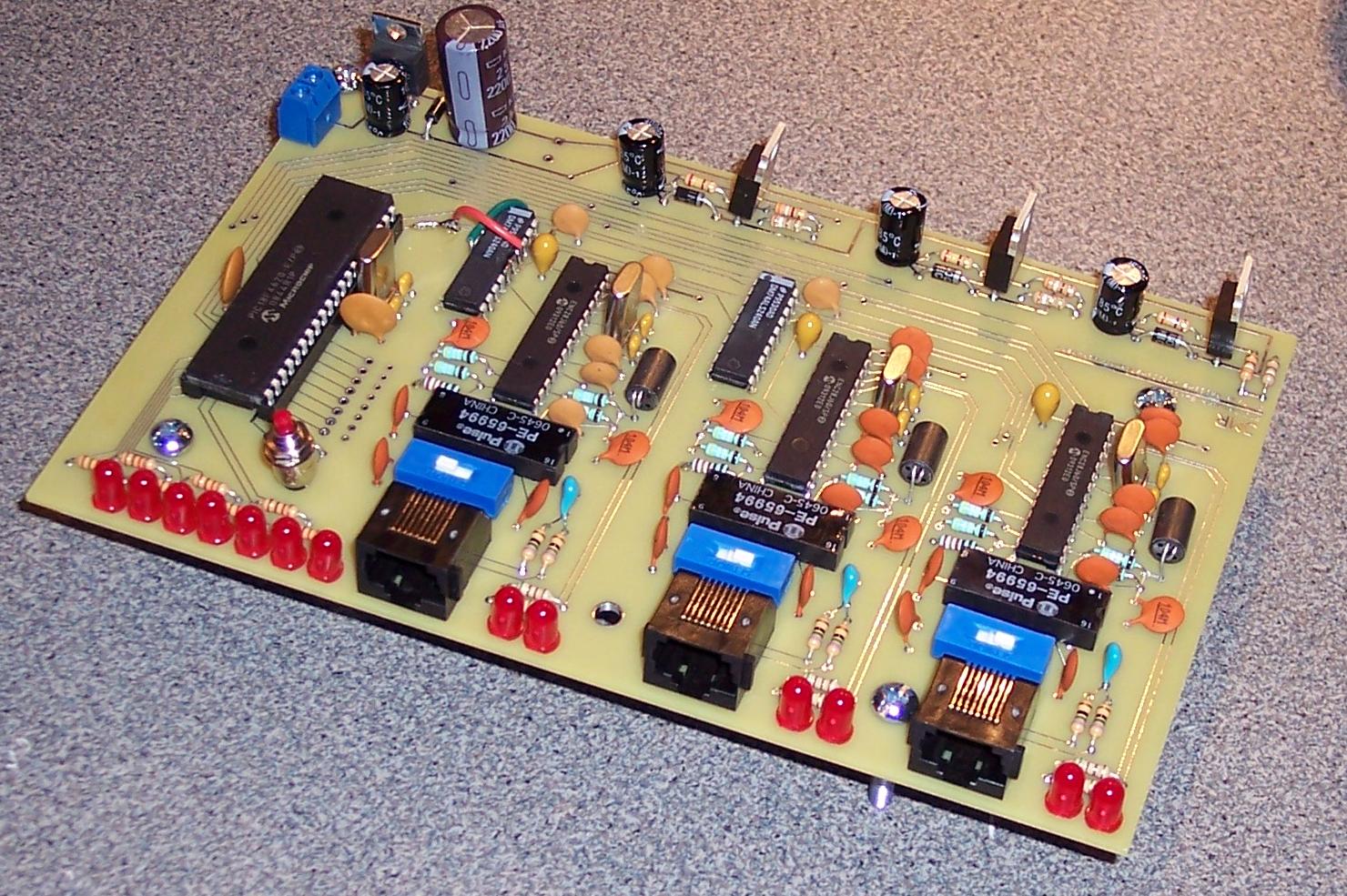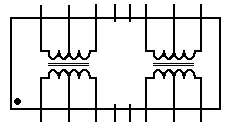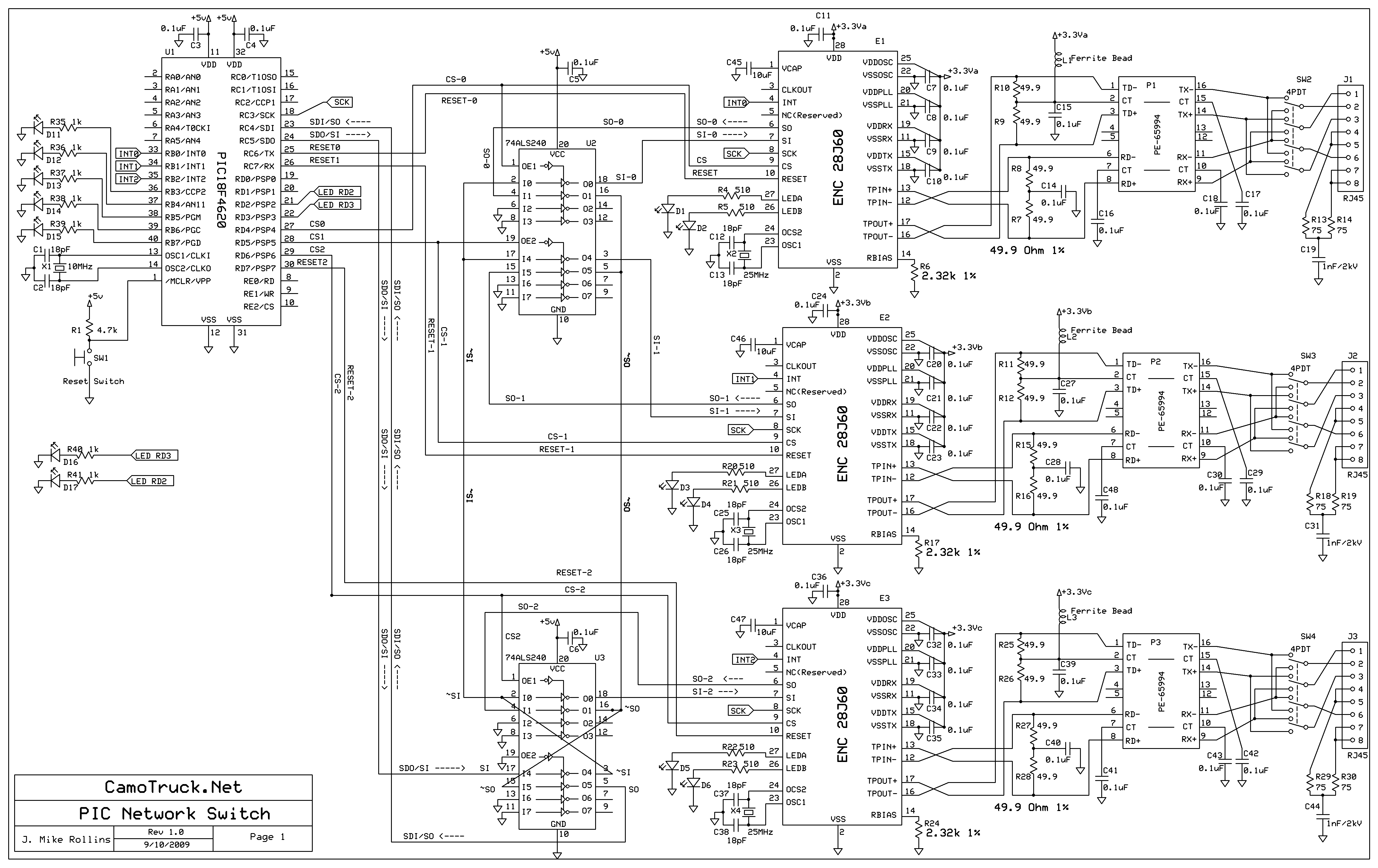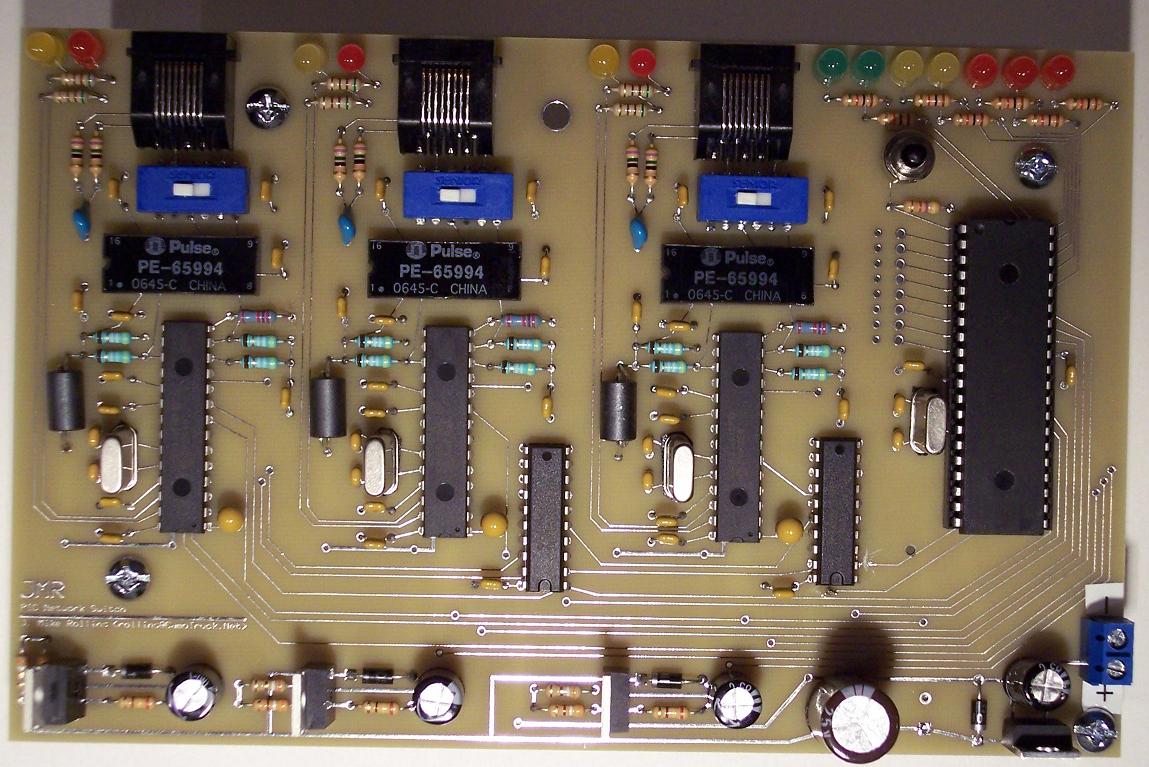PIC Switch
Aug 21, 2009 - Present
Open-source network device from scratch.
Linux and other Open-Source software has shown that even the hobbyist can build and improve production
quality software. I wondered if that same concept could apply to networking hardware.
This page will record my progress.
My first test was a repeater built on a breadboard.
I designed a PCB for my second test.
|
This is an experimental project in its initial stages. I welcome feedback and advice. I plan to keep this site updated as I progress. I offer the schematics, PCB design, parts list and firmware to anyone who might like to play along.
I welcome any constructive feedback.
|
click to enlarge/reduce

|
The following are the primary components for the Ethernet device:
- Pulse Transformer PE-65994
Ethernet signals are created using a pulse transformer to generate
a differential signal. These devices are
small, center-tapped transformers that come in pairs, one for send and one for receive.

- ENC28J60 Ethernet Controller
This IC drives the pulse transformer and handles the Ethernet protocol. This chip provides an interface using the
Serial Peripheral Interface Bus (SPI)
protocol.
- PIC18F4620 Microcontroller
The PIC Microcontroller is the heart of the device. It polls the ENC28J60 chips for data. It retrieves the data over the SPI bus, processes the data and sends it to the appropriate ENC28J60 chip.
- 74ALS240 Tri-state inverting buffer
Only one device may use the SPI bus at a given time. The 74ALS240 acts as a gate that allows the microcontroller
to communicate with one particular ENC28J60 chip. I selected an inverting buffer so that I could handle the
Logic Level shifting between the ENC28J60, which is a 3.3 volt device, and the PIC18F4620, which is a 5 volt device.
You will need a few items to begin working with the Microcontroller.
I purchased the PICSTART Plus Part Number: DV003001 kit from Microchip.
This kit includes the following:
- The programmer unit:
This is the device that writes the firmware to the chip. This interfaces with a
computer's serial port. On newer computers, you may need an additional
USB to Serial Converter.
- Compiler, Assembler and IDE:
The kit comes with a copy of the MPLAB IDE. This provides a development environment for many
different chips and supports C and Assembler programming languages. The IDE contains a simulator
and a debugger. Microchip provides a free license for the C compiler for learning.
|
I drew the schematic and board layout using the ExpressSCH and ExpressPCB software from Express PCB. I did make a couple of errors on my original PCB. (Notice the green and red wires in the photo.) The designs here have that error fixed, however, I have not ordered a new board yet to verify the corrections. You will need to install the software from ExpressPCB to view the schematic and PCB.
- View the parts list
- Download the schematic Requires ExpressSCH software.
- Download the PCB Requires ExpressPCB software.
- Download the Firmware This will make the device a repeater. It currently works in half-duplex only.
- This a very simple repeater. Whatever comes in one interface is echoed out the other interfaces.
I realized some bugs with the repeater image while I was working on the router code.
This version of the repeater does contain those bugs.
- Download the Router code This will make the device a router.
- The router will respond to ICMP echo request. But does not perform any other ICMP functions.
- It does perform proxy arp.
- It has a very simple arp table.
- It supports local networks for which it is the router.
- It supports a route configured on a network, such as a default gateway.
- It can send log messages to a syslog server.
- It has a route cache to speed up processing.
- To configure the router: A Perl script interprets a rule file and generates a rules.c file that you compile with the firmware.
- It currently works in half-duplex only. It might work in full-duplex, but I have not spent much time with this yet.
- I'm still reading the Router RFC 1812. I do have to say, it gets quite boring after about the first 60 pages.
Update: Oct 8, 2009 I finished the second board today. The minimum purchase is two boards when you buy boards from ExpressPCB. So, I did not want to let the second board go to waste. Today, I replaced the 2.32 kOhm resistor with 2.7 kOhm and tested the board. The board works as well as the first one did. I have a photo of this new board at the bottom of this page. My first board had two wires on the top to patch an over-site on the pcb. This time, I ran those on the bottom of the board. The PCB design available on this site does not have this problem.
Update: Oct 7, 2009 I made a second device using almost identical components. I had a few problems until I realized I had not grounded pin 19 on the SN74ALS241AN. This is fixed in the PCB above. I used three recently purchased ENC28J60 chips, but they are still using revision 4 code. This means I will have to replace the 2.32 kOhm RBIAS with 2.7 kOhm resistors. I will do this tomorrow.
Update: Oct 4, 2009 I made many modifications since my last update.
- The datasheet for the ENC28J60 specifies an external 2.32 kOhm, 1% resistor attached from RBIAS to ground.
However, I found that my chip is Rev 4. The Errata for this version recommends a 2.70 kOhm, 1% resistor.
I found some 2% at a local electronics store and replaced them.
- I still had a noticeable number of dropped packets. I scanned the code and added a few checks for MACIsTxReady
an made sure the WritePointer was set correctly.
- I really needed a way to know what was happening. I did not plan a UART interface for this version and there
is only so much information you can get from 7 LEDs. So, I added syslog support. In most of my testing, I used
only interface 0 and interface 2. So, I made interface 1 send data to a syslog server. This configuration
options is now part of my rules.txt file.
- I added a function to send the ENC28J60 revision number to the syslog server. I also added a function to send
the number of packets queued in the receive buffer. I noticed that the buffer was full when the packets were
lost. This means I need to get the packets out of the buffer faster.
- The buffer on the ENC28J60 is 8K. The max RAM on the PIC18F4620 is 4K. I increased the PIC's buffer to 1520 bytes.
This took a good chunk of memory, but it would allow an entire packet to be transferred in one chunk.
- This did speed things up quite a bit, but still not enough. I considered improving the crude routing algorithm,
but decided to make a route cache instead. The routing algorithm is executed on the first packet. Then the
routing information is saved and indexed by the source and destination IP address. The speed up was considerable!
- I still wanted an indication of whether packets were lost. Creating a syslog entry on every packet is quite verbose.
The ENC28J60 has an interrupt pin. I included a connection for this on my PCB, but had never used this feature.
I read the data sheets and wrote some code and now have a syslog message written when there is packet loss due to
RX buffer space constraints.
- Conclusion: For my definitive test, I decided to see if I could stream from YouTube the
song "White and Nerdy". The buffer remained full! There were not hiccups. I consider this a success.
I looked to see if there were any chips that had more RAM. Unfortunately, the better options are in the PIC32
series. Additionally, there is a new Ethernet chip the ENC424J600/624J600. Both of these are surface mount chips.
I would need to dive into surface mount electronics and get an upgraded programmer. This
would be a $1000 dollar investment. I was considering a MIG Welder for my next toy. Now, I will have to
think about this for a while.
Update: Sep 30, 2009 I observed many re-transmissions in a sniffer trace recording an ftp test.
I discovered the value of the "Errata". I wrote a function to display the revision number of the chips
and discovered I was using version 4. These were chips I purchased over a year ago.
I found that my revision deviates a little from the datasheet.
There seem to be some bugs with this version. This may explain the performance issues. I shall attempt
to implement the work-around to see if that fixes the performance issues.
Update: Sep 29, 2009 I did some performance tests. The device is slower than a 10 Meg Ethernet hub.
I'm not sure what is limiting the speed. I'm currently experimenting with buffer sizes, and reading the
data sheets.
Update: Sep 28, 2009 I added some comments and continued to review the Router RFC.
Update: Sep 27, 2009 After a couple weeks of study and development, I made the device route IP traffic.
The code needs quite a bit of cleanup and improvements. I'm using less than half of the available programming space.
It looks like there will be much room to add new features. The next version of the hardware will probably contain
an RS232 terminal port and maybe four Ethernet ports. For now, my focus will be on code cleanup and speed.
|
|
Large image of schematic

|
|
click to enlarge/reduce

Really Big Photo
Please note that this is an experimental project.
Use at your own risk.
THE SOFTWARE AND DOCUMENTATION ARE PROVIDED "AS IS" WITHOUT
WARRANTY OF ANY KIND, EITHER EXPRESS OR IMPLIED, INCLUDING WITHOUT
LIMITATION, ANY WARRANTY OF MERCHANTABILITY, FITNESS FOR A
PARTICULAR PURPOSE, TITLE AND NON-INFRINGEMENT. IN NO EVENT SHALL
THE AUTHOR NOR MICROCHIP BE LIABLE FOR ANY INCIDENTAL, SPECIAL, INDIRECT OR
CONSEQUENTIAL DAMAGES, LOST PROFITS OR LOST DATA, COST OF
PROCUREMENT OF SUBSTITUTE GOODS, TECHNOLOGY OR SERVICES, ANY CLAIMS
BY THIRD PARTIES (INCLUDING BUT NOT LIMITED TO ANY DEFENSE
THEREOF), ANY CLAIMS FOR INDEMNITY OR CONTRIBUTION, OR OTHER
SIMILAR COSTS, WHETHER ASSERTED ON THE BASIS OF CONTRACT, TORT
(INCLUDING NEGLIGENCE), BREACH OF WARRANTY, OR OTHERWISE.
|